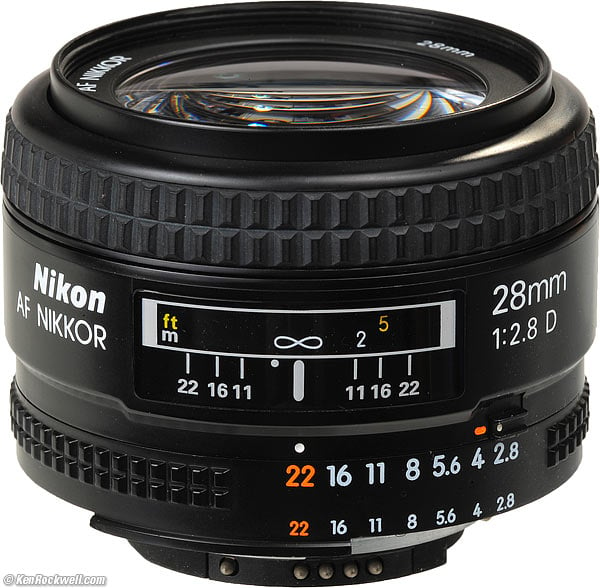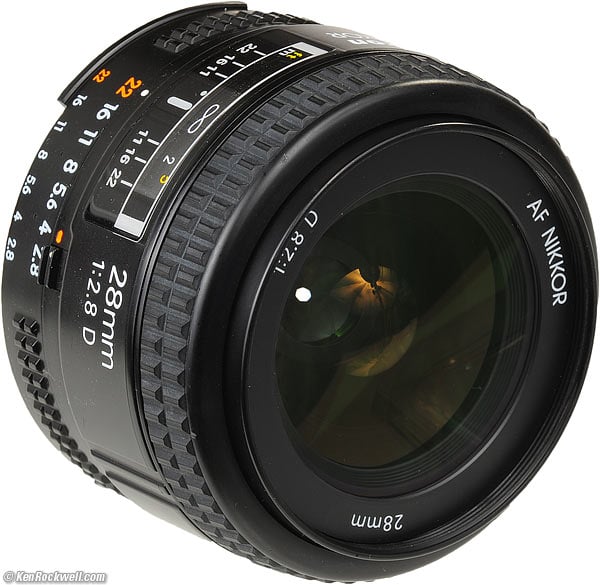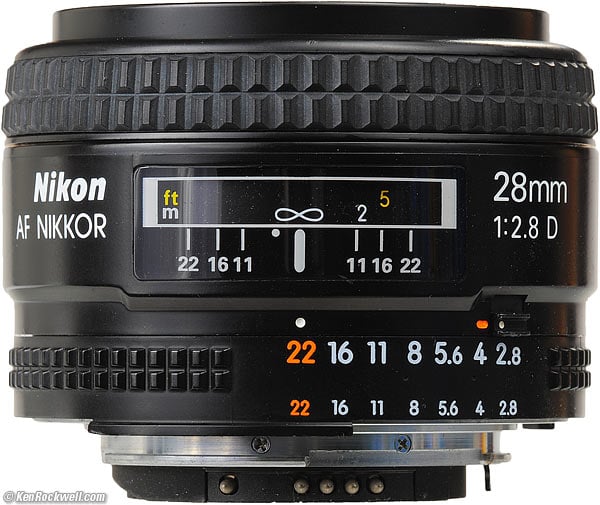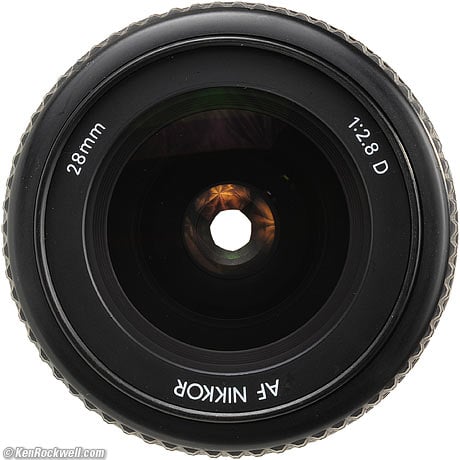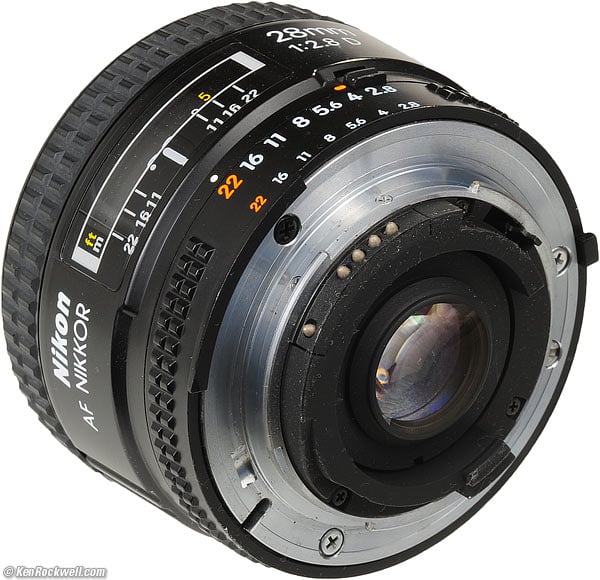Home Donate New Search Gallery How-To Books Links Workshops About Contact
Nikon 28mm f/2.8 AF-D
$265 (1994-today)
© 2010 KenRockwell.com. All rights reserved.
Intro Specifications Performance Recommendations
Nikon AF-NIKKOR 28mm f/2.8 D ($265, 52mm filters, 7.3oz/206.1g). enlarge. I'd get it at Adorama or Amazon. It helps me keep adding to this site when you get yours from those links, too. Thanks! Ken.
July 2014 Nikon Reviews Nikon Lenses All Reviews
Ideal Uses: Inexpensive, lightweight lens for use on FX digital, DX digital and film.
Not for: I wouldn't bother with this on a DX camera. I'd use any DX lens, like the 18-55mm kit lens, instead. This lens will not autofocus with the cheapest D40, D40x, D60, D3000 or D5000; get an AF-S lens, like the kit lens, instead for those cameras.
| Optics: | |
| Mechanics: | |
| Ergonomics: | |
| Usefulness: | |
| Availability: | |
| Overall: |
Introduction top
Intro Specifications Performance Recommendations
This 28mm f/2.8 AF-D lens is a lightweight wide-angle lens for all Nikon digital, AF and manual-focus film cameras.
It sells for about $265 brand-new.
If you're counting every pixel on a D3X you might want a sharper lens like the 24-70mm f/2.8 AF-S G, but for every other use, it's swell, and very inexpensive.
I wouldn't buy this lens. I'd get the optically far superior, slightly heavier and slightly more expensive 24mm f/2.8 AF-D instead. They look similar, but are completely different inside.
Nikon 28mm f/2.8 AF-D. enlarge.
Compatibility back to intro back to top
The Nikon 28mm f/2.8 AF-D works great with almost every film and digital Nikon camera made since 1977. If you have a coupling prong added to the diaphragm ring, it's perfect with every Nikon back to the original Nikon F of 1959.
The only incompatibility is that it will not autofocus with the cheapest D40, D40x, D60, D3000 or D5000, but if you focus manually, everything else works great. These cameras have in-finder focus confirmation dots to help you.
See Nikon Lens Compatibility for details on your camera. Read down the "AF, AF-D (screw)" column for this lens.
History back to intro back to top
1950s
Nikon made 28mm f/3.5 for its S-series rangefinder cameras. It's not very good, but it is tiny.
1960-1983
Nikon made 28mm f/3.5 F, AI and AI-s lenses in several iterations.
1974-1981
Nikon made the 28mm f/2.8 AI, which had 7 elements in 7 groups.
It lacks CRC and focuses to only 1 foot, and is a great lens. It is better optically than this AF-D lens today.
1979-1995
Nikon made an optically inferior 5-element 28mm f/2.8 lens that was sold as the Series E, and also as the first two iterations of non-D AF lenses.
1981-today
Today's manual-focus 8-element 28mm f/2.8 AI-s lens came out in 1981, and has been sold unchanged ever since.
The manual-focus lens has superior optics and mechanics to this plastic-barreled AF-D lens.
1994-today
Nikon redesigned the crummy 5-element 28mm f/2.8 design, used for the Series E through the original AF version, into this 6 element 28mm f/2.8 AF-D version.
This lens looks the same on the outside as the first 28mm f/2.8 AF of 1986, however this AF-D lens has better optics, redesigned in 1994.
Nikon has made about 80,000 of these AF-D lenses since 1994.
THis AF-D lens' performance is still poorer than the 8-element manual-focus 28mm f/2.8 AI-s, which is also still sold new today.
Specifications with commentary top
Intro Specifications Performance Recommendations
Nikon 28mm f/2.8 AF-D. enlarge.
Name
Nikon calls this the Nikon AF-NIKKOR 28mm f/2.8 D. The "D" means this lens tells the camera the distance to the subject, which helps the exposure meter, especially with on-camera flash.
Optics
6 elements in 6 groups.
It's multicoated, which Nikon calls Nikon Integrated Coating.
Nikon 28/2.8 AFD at f/5.6. enlarge.
|
I personally buy from Adorama, Amazon, Ritz, B&H, Calumet and J&R. I can't vouch for ads below.
|
Diaphragm
7 straight blades.
Stops down to f/22.
Close Focus
0.8 feet (0.25m).
Maximum Reproduction Ratio
1:5.6.
Hard Infinity Focus Stop?
Yes.
This is great for astronomy; just turn to the stop and you have fixed laboratory-perfect focus all night.
Focus Scale
Yes.
Depth-of-Field Scale
Yes.
Infra-Red Focus Index
Yes, white dot in depth-of-field scale.
Aperture Ring
Yes.
Full-stop clicks.
Filter Thread
52mm, plastic.
Does not rotate.
Size
Nikon specifies 44.5 mm extension from flange (54 mm overall) by 65 mm diameter.
Weights
7.270 oz. (206.1g), as measured by me.
Nikon specifies 7.2 oz. (205g).
Hood
HN-2 metal screw-in, not included.
Case
Optional CL-30S, No.61, CL-34A, or CL-S1.
Teleconverters
TC-200/201 and TC-14A, but why on Earth would you want to convert this to a manual-focus 40mm f/4 or 55mm f/5.6 lens when it's less expensive, lighter, less expensive, faster, better and easier to carry a dedicated 50mm f/1.8 lens instead?
Introduced
1994.
Nikon Product Number
1922.
Price
$265, USA, July 2010.
$275, USA, November 2009.
Performance top
Intro Specifications Performance Recommendations
Overall Focus Distortion Ergonomics Falloff Filters
Color Fringes Mechanics Sharpness Sunstars
Overall back to Performance back to top
The Nikon 28mm f/2.8 AF-D is one of Nikon's cheapest lenses, and unfortunately, not that good a performer if you're counting all your pixels.
Used properly (stopped down to f/8), it can give excellent results; just don't look in the corners with a microscope on a D3X at f/2.8. Stop it down to f/11 for the best results in the corners.
Focus back to Performance back to top
Auto/Manual Switching
You have to move the switch on the camera to get Auto or Manual focus.
In AF, the manual focus ring moves. Keep your fingers off of it, because if you don't, the lens won't focus.
AF Speed
One full turn (two half-turns) of the AF screw pulls focus from infinity down to 3 feet, which is fast AF performance.
AF Accuracy
AF is always right-on.
Manual Focus
Manual focus is easy, once you've moved the switch on your camera.
This lens works great on all manual focus and film cameras.
Distortion back to performance back to top
The 28mm f/2.8 AF-D has a moderate amount of barrel distortion.
This can be corrected for critical use at infinity by plugging +2.0 into Photoshop's lens distortion filter. Use +1.0 at about 5 feet (1.5m).
Even when this is done, the distortion is slightly complex and is still a little wavy after this simple correction. For better correction, you'll need a higher-order correction tool, like a plug-in for DxO.
Ergonomics back to performance back to top
Nikon 28mm f/2.8 AF-D. enlarge.
Ergonomics are great, except for having to fiddle with a switch on the camera to go between auto and manual focus.
For use on manual-focus cameras, it is almost as good as a dedicated manual focus lens.
Falloff (darkened corners) back to performance back to top
Falloff on FX is no big deal.
There is a little at f/2.8, and almost none at f/4. It's gone by f/5.6.
You won't see this in photography of anything except blank walls.
It won't be an issue at all on DX (see crop factor).
Filters, Use with back to Performance back to top
There is no problem with vignetting. Use any 52mm filter.
Two filters at the same time would be pushing it.
The filter ring does not rotate.
Lateral Color Fringes back to Performance back to top
There are no lateral color fringes on the D3, which would correct them if the lens had any.
Mechanics back to Performance back to top
Rear, Nikon 28mm f/2.8D AF . enlarge.
Barrel Exterior: Plastic.
Filter Threads: Plastic.
Focus Ring: Plastic; rubber covered.
Focus Helicoids: Feel like plastic.
Depth-of-Field Scale: Yes.
Internals: Seem like metal and plastic.
Aperture Ring: Plastic with painted numbers.
Focus Geartrain: Metal.
Mount: Dull-chromed brass.
Markings: Paint.
Serial Number: Laser engraved onto bottom rear of aperture ring.
Ass-Gasket (dust seal at mount): No.
Noises When Shaken: Mild clunking from the sloppy AF helicoid.
Made in: Japan, at least the one I show here from about 1998.
Sharpness back to Performance back to top
Warning 1: Image sharpness depends more on you than your lens.
Warning 2: Lens sharpness doesn't mean much to good photographers.
With those caveats, the 28mm f/2.8 AF-D is always sharp in the center, and softer in the corners on FX at larger apertures. Compared to a Tokina 28-70mm f/2.8 ATX, this Nikon lens is much sharper in the center at f/2.8.
Stop down to f/11 for the sharpest corners.
At f/2.8: Sharp center and sides, blurry corners.
At f/4: Sharp center and sides, slightly blurry corners.
At f/5.6: Sharp center and sides, decent corners, but still a little blurry in the farthest corner if you're looking way too closely.
At f/8: Just about optimum.
At f/11: Optimum from corner-to-corner.
At f/16: Diffraction limits performance.
At f/22: Diffraction limits performance.
Sunstars back to Performance back to top
With its straight 7-bladed diaphragm, the 28/2.8 should make magnificent Nikon-hallmark fourteen-pointed sunstars on bright points of light.
Recommendations top
Intro Specifications Performance Recommendations
The Nikon 28mm f/2.8 AF-D is not a stellar performer, but used properly, can create extraordinary images.
This 6-element AF-D lens (1994-present) is much better optically than the Series E (1979-1985) and original AF (1986-1994) 28mm f/2.8 lenses, both of which used the same awful 5-element amateur design.
This 6-element AF-D lens isn't that great if you're counting your pixels. If you are, use the superior 8-element 28mm f/2.8 AI-s, any of the pro zooms like the 24-70mm f/2.8 AF-S, or the scaldingly expensive 28mm f/1.4 AF-D.
The slightly wider-angle, slightly heavier 24mm f/2.8 AF-D is a much better professional lens. So are older manual-focus 28mm f/2.8 lenses.
In this case, Nikon got cheap with all its 28mm f/2.8 autofocus lenses because it thought, and rightly so, that they are mostly bought by price-conscious amateurs. Thus Nikon made this lens affordable, not spectacular.
All in all, this 28mm f/2.8 AF-D lens works on the newest D3X, D3 and D700 cameras, and it makes a perfect lens to use with Nikon's lightweight full-frame cameras like the N75.
Deployment
I'd leave either a 52mm Nikon Clear (NC - UV) filter, or a 52mm Hoya Super HMC UV on the lens at all times.
I wouldn't bother with a hood, but don't let me stop you.
If I was working in nasty, dirty areas, I'd forget the cap, and use an uncoated 52mm Tiffen UV filter instead. Uncoated filters are much easier to clean, but more prone to ghosting.
More Information: Nikon, Japan.
Help me help you top
I support my growing family through this website, as crazy as it might seem.
If you find this as helpful as a book you might have had to buy or a workshop you may have had to take, feel free to help me continue helping everyone.
If you've gotten your gear through one of my links or helped otherwise, you're family. It's great people like you who allow me to keep adding to this site full-time. Thanks!
If you haven't helped yet, please do, and consider helping me with a gift of $5.00.
The biggest help is when you use any of these links when you get anything. It costs you nothing, and is this site's, and thus my family's, biggest source of support. These places always have the best prices and service, which is why I've used them since before this website existed. I recommend them all personally.
Thanks for reading!
Ken
Home Donate New Search Gallery How-To Books Links Workshops About Contact

